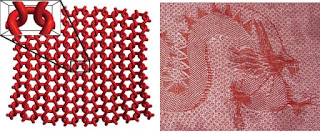For the most part, knitters concern themselves with the number of stitches and where to make a loop change. They use repeating patterns to create cables and designs. What they don't consider is Physics.
Well, the Physicists are taking notes and it turns out knitting is pretty darn complex. They love it.1
There are several interesting areas:
 |
| Strechiness |
Material Properties. The end product displays properties beyond that of the base material used. Taking a one dimensional shape (yarn) and turning it into a multidimensional object (sweater). The sweater has many times the strength of the individual yarns or loops.
 |
| Smocking Variations2 |
Knitted knots are interlocking slip knots looped back and forth. A knot pulled to the front is a "knit stitch" and a knot pulled to the back is a "purl stitch". Combining front and back knots creates the pattern and linking them in different ways creates 3D shapes.
Each stitch or pattern yields a different amount of elasticity. Not only does it expand but it returns to the original shape. The amount of "give" depends on how many stitches are linked or crossed over the neighboring loops. Physicists are working out the math that goes into how a single thread of yarn becomes a bendable knitted item and how much stretchiness it will display. Once they sort it all out, they can use predictive modeling for new materials and new applications for knitted items.
Analyzing Weasley Sweaters is just the start.
 |
| Knitting Slip Knot |
References
- https://arstechnica.com/science/2019/03/physicists-are-decoding-math-y-secrets-of-knitting-to-make-bespoke-materials/
- https://en.wikipedia.org/wiki/Smocking
Smocking Stitches A Cable stitch B Stem stitch C Outline stitch D Cable flowerette E Wave stitch F Honeycomb stitch G Surface honeycomb stitch H Trellis stitch I Vandyke stitch J Bullion stitch
No comments:
Post a Comment